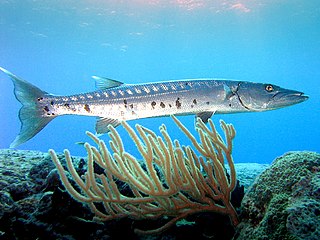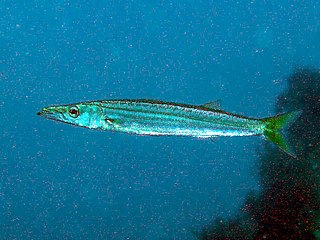
A barracuda is a large, predatory, ray-finned fish known for its fearsome appearance and ferocious behaviour. The barracuda is a saltwater fish of the genus Sphyraena, the only genus in the family Sphyraenidae, which was named by Constantine Samuel Rafinesque in 1815. It is found in tropical and subtropical oceans worldwide ranging from the eastern border of the Atlantic Ocean to the Red Sea, on its western border the Caribbean Sea, and in tropical areas of the Pacific Ocean. Barracudas reside near the top of the water and near coral reefs and sea grasses. Barracudas are targeted by sport-fishing enthusiasts.

The Priacanthidae, the bigeyes, are a family of 18 species of marine ray-finned fishes. "Catalufa" is an alternate common name for some members of the Priacanthidae. The etymology of the scientific name refers to the family's very rough, spined scales. The common name of "bigeye" refers to the member species' unusually large eyes, suited to their carnivorous and nocturnal lifestyles. Priacanthidae are typically colored bright red, but some have patterns in silver, dusky brown, or black. Most species reach a maximum total length of about 30 cm (12 in), although in a few species lengths of over 50 cm (20 in) are known.

The Gempylidae are a family of scombriform ray-finned fishes commonly known as snake mackerels or escolars. The family includes about 25 species.

The pickhandle barracuda is a species of barracuda found throughout the Indo-Pacific region. Its common name derives from the dark marks along its sides, which look like the thick ends of pickaxe handles. Sea anglers sometimes colloquially shorten the name to "pick". Other common names for the species include banded barracuda, yellowtail barracuda, and sea pike.

Naso vlamingii, the bignose unicornfish, scibbled unicornfish, Vlaming's unicornfish, and zebra unicornfish, is a species of marine ray-finned fish belonging to the family Acanthuridae, the surgeonfishes, unicornfishes and tangs. This species is found in the Indo-Pacific.

The yellowtail barracuda is one of the smaller species of barracuda of the family Sphyraenidae, which can be found in Indo-West Pacific oceans. It has also invaded the Mediterranean through the Suez Canal from the Red Sea, making it one of the Lessepsian migrants.

Sphyraena barracuda, commonly known as the great barracuda, is a species of barracuda: large, predatory ray-finned fish found in subtropical oceans around the world.
The northern sennet, Sphyraena borealis, is an ocean-going species of fish in the barracuda family, Sphyraenidae. It was described by the American zoologist James Ellsworth De Kay in 1842. De Kay's description was part of several volumes he published regarding the fauna of New York from 1842-1849. Northern sennet are also known as northern barracuda. While generally considered a gamefish it has only rarely been used as food by humans.
The Guachanche barracuda is an ocean-going species of game fish in the barracuda family, Sphyraenidae. It was described by the French zoologist Georges Cuvier in 1829. The description was part of the second edition of Le Règne Animal, or The Animal Kingdom. Guachanche barracuda are also known simply as guaguanche throughout much of the Caribbean. When used for food, Guaguanche barracuda are usually sold fresh or salted.

Sphyraena argentea is a predatory species of marine barracuda fish of the family Sphyraenidae. They are found in the northeast Pacific Ocean, from Cabo San Lucas, Baja California Sur north to Washington State. However, they are not common north of Point Conception in Santa Barbara County, California, usually preferring warmer waters. They can reach a length of about 1.2 metres (3.9 ft) and a weight of about 6.8 kilograms (15 lb). This species of barracuda is a very popular sport fish in Southern California.

Pristigenys niphonia, the Japanese bigeye, is a species of marine ray-finned fish in the family Priacanthidae. It occurs in the western Pacific Ocean.
Sphyraena sphyraena, also known as the European barracuda or Mediterranean barracuda, is a ray-finned predatory fish of the Mediterranean basin and the warmer waters of the Atlantic Ocean.
Sphyraena viridensis, the yellowmouth barracuda or yellow barracuda is a predatory ray-finned fish from the family Sphyraenidae, the barracudas. It is found in the warmer waters of the eastern Atlantic Ocean and the Mediterranean. It is often confused with the European barracuda.

Sphyraena chrysotaenia, the yellowstripe barracuda, is a species of predatory, ray finned fish from the family Sphyraenidae which is found in the Indo-West Pacific region. It has entered the Mediterranean Sea from the Red Sea through the Suez Canal as a Lessepesian migrant and is now an important species in the fisheries of the eastern Mediterranean.

The Japanese barracuda is a species of ray-finned fish of the family Sphyraenidae, which can be found in West Pacific ocean near southern Japan as well as in the South China Sea.

Sphyraena ensis, commonly known as the Mexican barracuda or simply barracuda, is a species of barracuda that inhabits the continental shelf of the Eastern Pacific from southern California to northern Chile. They have a long cylindrical body and are silvery in color, with a protruding lower jaw containing many sharp teeth of unequal size. Often found in schools, they can be found from coastal habitats such as estuaries and mangroves out into deeper water. Due to their abundance they are an important food fish for the region.

Sphyraena afra, commonly known as the Guinean barracuda, is a species of barracuda found off the western coast of Africa from Senegal to Namibia. They are not particularly common throughout their range. They are carnivorous, feeding on fish and shrimp. They are found on the continental shelf and are known to occur from lagoons and estuaries out to a depth of 75 m (246 ft).

Sphyraena pinguis commonly known as the red barracuda, striped barracuda, brown barracuda, and more names, is a species of barracuda found in the Northwest Pacific, from Southeast Asia up through Japan. It is a pelagic species commonly found in large schools over muddy or sandy rock bottoms from southern Japan to Australia. They can commonly be found inhabiting large estuaries and coastal bays and juveniles can be found in shallow waters. Red Barracuda feed on smaller fish and can get up to 50 cm(20 in) long.
Sphyraena iburiensis is a relatively recently discovered species of barracuda in the genus Sphyraena only being formally described in 2005. Found in the Eastern Pacific most commonly between southern Japan and Taiwan. They can be differentiated from other species of Barracuda by the number and lay out of their scales and the presence of two distinctive longitudinal stripes. The lower of the two stripes are especially distinct stretching from the snout to the base of the caudal fin just below the lateral line. The species is also known for having a completely transparent membrane on the first dorsal fin.

Sphyraena putnamae, the sawtooth, chevron or military barracuda, is a species of barracuda found in all tropical seas and temperate waters of major oceans with the exception of the eastern pacific. It is found near shores in bays, turbid lagoons, and some reefs. A recognizable feature is the many dark chevron-shaped markings along its side, and its forked caudal fin. It spends its time in the shallow part of the sea off the coast, and stays closers to the surface levels of the open ocean. It can reach an age of 14 years old, and grow up to six feet long and over 100 pounds.














